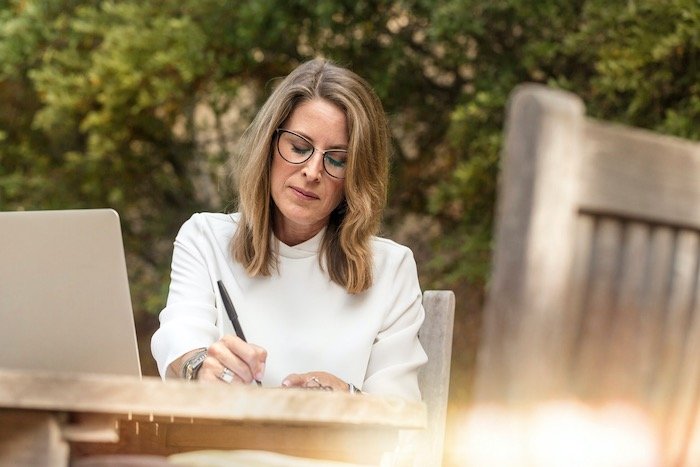
You’ve heard about encouraging the renewal and “regeneration” of skin in beauty circles, but what does that mean, exactly? What is regeneration when it comes to the skin, and why is it important?
What is Skin Regeneration?
The skin acts as an essential barrier, protecting you from your environment. It’s composed of three basic layers:
- The epidermis, or outer layer.
- The dermis, which sits just below the epidermis.
- Subcutaneous tissue, which is the innermost layer.
The epidermis is constantly renewing itself, shedding dead skin cells and replacing them with new, healthy cells in a sort of skin renewal process. Every time you wash, exfoliate, or rub something against your skin, you lose some dead cells and allow younger ones to take their place. This process of losing the old and replacing it with the new is called skin renewal and regeneration.
The full regeneration cycle of the epidermis takes about 28 days. As we get older, this process slows down, which means that the dead skin cells remain on the skin for longer than usual, causing that dry, flaky, and dull look.
As we age, we want to do what we can to encourage regeneration. We want those young, healthy cells to be visible, so we have to speed up the process of skin renewal, shedding the dead skin to allow the new, youthful skin to appear.
The dermis can regenerate too, but it takes much longer and is not something you can see as clearly with the naked eye. If you hurt yourself, though—maybe you cut the skin with a knife—the skin will go through a process of regeneration to heal that wound which will encompass all of the layers affected.
Indeed, during normal wound healing, human skin repairs itself slowly, forming new cells and fibers that gradually close the wound, and then smooth it over again, though there may be a scar. In this way, the skin truly renews itself, creating new skin over the old, injured skin.
As we age, this form of wound-healing regeneration and skin renewal slows too, which is why wounds heal more slowly in older people than they do in young people.
No matter which type of regeneration you’re talking about—of the outer layer or deeper layers—regeneration is something we want to encourage for the health and appearance of the skin.
What Slows Down Skin Regeneration?
Both physical and environmental factors can contribute to a slower regeneration process. These may include:
- Sunlight: UV rays can create damaging free radicals that slow regeneration. Wind and pollution can also be destructive.
- Diet: A poor diet that includes a lot of fast food or sugary foods can inspire inflammation in the skin, which slows regeneration.
- Age: As we age, the skin renewal and regeneration naturally slows down.
- Decreased blood flow: People with diabetes or other diseases that affect blood flow may experience slower wound healing.
- Obesity: Fat cells increase free radical generation in the body, which can damage normal cellular processes, making it more difficult for the skin to renew itself.
- Dry skin: Dry skin increases the risk of inflammation and infection, which can impair regeneration.
How Can I Speed Up Skin Regeneration?
To encourage your skin to regenerate faster, try these tips.
Protect your skin from the elements.
A little sun every day can be good for you. It helps the skin create vitamin D, which is needed for optimal health and can also help reduce the symptoms of psoriasis and eczema. About a half-hour is usually enough, however, so after that, make sure you’re applying sunscreen and using clothing to protect your skin from the sun, pollution, and harsh weather elements.
Use a mild cleanser.
Harsh cleansers take a toll on the skin. They can cause dry skin, which slows regeneration and results in irritation and inflammation. After cleansing your skin, ask yourself how it feels. If it’s tight and uncomfortable, try another cleanser.
Keep the skin properly moisturized.
Dry skin is aging skin, and it doesn’t regenerate as well. Make sure you moisturize regularly with a quality moisturizer that contains natural and safe ingredients. Products with pore-clogging ingredients like mineral oil reduce regeneration over time. (Try our quality moisturizers instead!)
Also, keep yourself hydrated from the inside out. Even mild dehydration can cause your body to steal moisture from your skin to deliver to other critical organs.
Use a vitamin C product.
Vitamin C is known to stimulate collagen synthesis in the skin, which is also a way to activate the skin’s natural regeneration process. Choose a vitamin C powder to mix in with your face cream, or try a vitamin C anti-aging serum.
Regularly exfoliate the skin.
Every time you exfoliate the skin, you encourage skin renewal and regeneration. Exfoliation is a type of irritation that helps slough off those old dead skin cells. That forces your skin to push the younger cells up to the surface, where they appear much smoother and softer.
Consider using a retinoid.
Retinoids are forms of vitamin A that are known to have a major influence on cell proliferation and growth. Some retinoids can be irritating—especially to sensitive skin—so it may take some trial and error to find one that works for you. Those with extended-release properties often work well without causing irritation or breakouts.
Have you noticed your skin regeneration slowing down?
Photo by Andrea Piacquadio from Pexels

